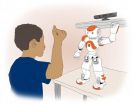(Press-News.org) LOS ANGELES - August 28, 2014: This week, a team of researchers from the USC Viterbi School of Engineering will share results from a pilot study on the effects of using humanoid robots to help children with autism practice imitation behavior in order to encourage their autonomy. Findings from the study, entitled "Graded Cueing Feedback in Robot-Mediated Imitation Practice for Children with Autism Spectrum Disorders," will be presented at the 23rd IEEE International Symposium on Robot and Human Interactive Communication (RO-MAN) conference in Edinburgh, Scotland, on Aug. 27.
The pilot study was led by Maja Matarić, USC Viterbi Vice Dean for Research and the Chan Soon-Shiong Chair in Computer Science, Neuroscience and Pediatrics, whose research focuses on how robotics can help those with various special needs, including Alzheimer's patients and children with autism spectrum disorders (ASD). Her research team included doctoral student Jillian Greczek, postdoctoral researcher Amin Atrash, and undergraduate computer science student Edward Kaszubski.
"There is a vast health care need that can be aided by intelligent machines capable of helping people of all ages to be less lonely, to do rehabilitative exercises, and to learn social behaviors," said Matarić. "There's so much that can be done that can complement human care as well as other emerging technologies."
For the study, the researchers examined how children with ASD react to humanoid robots that provide graded cueing, an occupational therapy technique that shapes behavior by providing increasingly specific cues, or prompts, to help a person learn new or lost skills. Matarić and her team divided a group of 12 high-functioning children with ASD into two groups, one experimental and one control. Each child then played an imitation game ("copycat") with a Nao robot that asked the child to imitate 25 different arm poses.
"In this study we used graded cueing to develop the social skill of imitation through the copycat game," said Jillian Greczek, who oversaw the study. "Our hope is that learning such skills could be generalized. So, if a child with autism is at recess with friends, and some kids are playing Red Light/Green Light, the child might look at the game and say, 'Oh, I see how to play, and I can play with them too."'
When a child in either group imitated the pose correctly, the robot flashed its eyes green, nodded, or said "Good job!" When a child in the control group failed to imitate the pose correctly, the robot simply repeated the command without variation. However, for the experimental group participants, the Nao robot offered varied prompting when a child did not copy the pose accurately, at first providing only verbal cues and then following up with more detailed instructions and demonstrations of the pose.
The study showed that children who received the varied prompting (graded cueing feedback) until the correct action was achieved, showed improved or maintained performance, while children who did not receive graded cueing regressed or stayed the same. These results suggest that varied feedback was more effective and less frustrating to the study participants than merely receiving the same prompt repeatedly when they did not imitate the pose correctly. Furthermore it demonstrates that a socially assistive robot can be effective at providing such feedback.
Although this study did not exercise the graded cueing model to its fullest, the preliminary results show promise for the use of this technique to improve user autonomy through robot-mediated intervention. Matarić hopes that, within a decade, children with ASD might have their own personal robots to assist them with therapy, help prompt them through daily tasks, coach them through interactions with others, and encourage them to play with peers.
"The idea is to eventually give every child a personalized robot dedicated to providing motivation and praise and nudges toward more integration," Matarić said.
INFORMATION:
This pilot study is part of ongoing work in socially assistive robotics under Matarić at The Interaction Lab, part of the USC Center for Robotics and Autonomous Systems (RASC), the USC Robotics Labs, and the USC Viterbi Computer Science Department. Research at The Interaction Lab focuses on the development of adaptive and personalized socially assistive robots that can help people with special needs to incorporate new healthy and therapeutic behaviors into their everyday lives.
This research was funded at USC by the National Science Foundation Human-Centered Computing grant and the National Science Foundation CISE Research Infrastructure grant.
About the USC Viterbi School of Engineering
Engineering Studies began at the University of Southern California in 1905. Nearly a century later, the USC Viterbi School of Engineering received a naming gift in 2004 from alumnus Andrew J. Viterbi and his wife Erna. Viterbi is the inventor of the Viterbi algorithm, now key to cell phone technology and numerous data applications. Consistently ranked among the top graduate programs in the world, the school enrolls more than 5,000 undergraduate and graduate students, taught by more than 174 tenured and tenure-track faculty, with 60 endowed chairs and professorships. http://viterbi.usc.edu
Socially-assistive robots help kids with autism learn by providing personalized prompts
Socially-assistive robots help children with autism learn imitative behavior with 'graded cueing'
2014-08-28
ELSE PRESS RELEASES FROM THIS DATE:
Flapping baby birds give clues to origin of flight
2014-08-28
How did the earliest birds take wing? Did they fall from trees and learn to flap their forelimbs to avoid crashing? Or did they run along the ground and pump their "arms" to get aloft?
The answer is buried 150 million years in the past, but a new University of California, Berkeley, study provides a new piece of evidence – birds have an innate ability to maneuver in midair, a talent that could have helped their ancestors learn to fly rather than fall from a perch.
The study looked at how baby birds, in this case chukar partridges, pheasant-like game birds from Eurasia, ...
Prions can trigger 'stuck' wine fermentations, researchers find
2014-08-28
A chronic problem in winemaking is "stuck fermentation," when yeast that should be busily converting grape sugar into alcohol and carbon dioxide prematurely shuts down, leaving the remaining sugar to instead be consumed by bacteria that can spoil the wine.
A team of researchers including UC Davis yeast geneticist Linda Bisson has discovered a biochemical communication system behind this problem. Working through a prion -- an abnormally shaped protein that can reproduce itself -- the system enables bacteria in fermenting wine to switch yeast from sugar to other food sources ...
Researchers use NASA and other data to look into the heart of a solar storm
2014-08-28
A space weather storm from the sun engulfed our planet on Jan. 21, 2005. The event got its start on Jan. 20, when a cloud of solar material, a coronal mass ejection or CME, burst off the sun and headed toward Earth. When it arrived at our planet, the ring current and radiation belts surrounding Earth swelled with extra particles, while the aurora persisted for six hours. Both of these are usually signs of a very large storm – indeed, this was one of the largest outpouring of solar protons ever monitored from the sun. But the storm barely affected the magnetic fields around ...
After Great Recession, Americans are unhappy, worried, pessimistic, Rutgers study finds
2014-08-28
NEW BRUNSWICK, N.J. – The protracted and uneven recovery from the Great Recession has led most Americans to conclude that the U.S. economy has undergone a permanent change for the worse, according to a new national study at Rutgers. Seven in 10 now say the recession's impact is permanent, up from half in 2009 when the recession officially ended, according to the John J. Heldrich Center for Workforce Development.
Among key findings in "Unhappy, Worried and Pessimistic: Americans in the Aftermath of the Great Recession," the center's latest Work Trends report, are:
Despite ...
A VA exit strategy
2014-08-28
LEBANON, NH – As the federal government plans its exit strategy from the war, now may be the time for it to rethink its role in providing health care to veterans, says a Perspective piece in the New England Journal of Medicine.
"To simply go on doing more of the same is to fail to recognize the challenge that the Veterans Health Administration's cost and population structure pose in the longer run," said William Weeks, from The Dartmouth Institute for Health Policy & Clinical Practice, and David Auerbach, from the RAND Corporation, in the August issue of NEJM.
The ...
The universal 'anger face'
2014-08-28
The next time you get really mad, take a look in the mirror. See the lowered brow, the thinned lips and the flared nostrils? That's what social scientists call the "anger face," and it appears to be part of our basic biology as humans.
Now, researchers at UC Santa Barbara and at Griffith University in Australia have identified the functional advantages that caused the specific appearance of the anger face to evolve. Their findings appear in the current online edition of the journal Evolution and Human Behavior.
"The expression is cross-culturally universal, and even ...
Climate change puts endangered Devils Hole pupfish at risk of extinction
2014-08-28
RENO, Nev. – Climate change is hurting reproduction of the endangered Devils Hole pupfish, threatening the survival of this rare species that has numbered as few as 35 individuals, new research by the University of Nevada, Reno and Desert Research Institute shows.
Scientists report that geothermal water on a small shelf near the surface of an isolated cavern in the Nevada desert where the pupfish live is heating up as a result of climate change and is likely to continue heating to dangerous levels.
The hotter water, which now reaches more than 93 degrees, has shortened ...
Deadly remedy: Warning issued about Chinese herbal medicine
2014-08-28
A herbal preparation prescribed by a Chinese herbal medication practitioner in Melbourne for back pain resulted in life-threatening heart changes, prompting a team of intensive care and emergency physicians to call for appropriate patient education by practitioners who prescribe complementary medications.
Writing in Emergency Medicine Australasia, the journal of the Australasian College for Emergency Medicine, emergency medicine trainees Dr Angelly Martinez and Dr Nicky Dobos from the Intensive Care Unit at the Royal Melbourne Hospital and emergency medicine trainee Dr ...
Are cigarette substitutes a safe alternative? It depends on user habits
2014-08-28
CORAL GABLES, Fla (Aug. 26, 2014)-- Cigarette smoking kills approximately 440,000 Americans each year, according to the Centers for Disease Control and Protection. It's the leading cause of preventable death worldwide. In order to overcome this addiction, many people resort to nicotine replacement therapies.
A recent literature review study by researchers at the University of Miami (UM) suggest that small dosages of nicotine found in cigarette substitutes could be harmful to human musculoskeletal system, due to overuse. The findings are reported in the Global Journal ...
From bite site to brain: How rabies virus hijacks and speeds up transport in nerve cells
2014-08-28
Rabies (and rabies virus, its causative agent) is usually transmitted through the bite of an infected animal into muscle tissue of the new host. From there, the virus travels all the way to the brain where it multiplies and causes the usually fatal disease. An article published on August 28th in PLOS Pathogens sheds light on how the virus hijacks the transport system in nerve cells to reach the brain with maximal speed and efficiency.
Pathogens that travel in the blood can spread throughout the body without much effort, courtesy of the heart's pumping action. Those traveling ...
LAST 30 PRESS RELEASES:
Scientists boost cell "powerhouses" to burn more calories
Automatic label checking: The missing step in making reliable medical AI
Low daily alcohol intake linked to 50% heightened mouth cancer risk in India
American Meteorological Society announces Rick Spinrad as 2026 President-Elect
Biomass-based carbon capture spotlighted in newly released global climate webinar recording
Illuminating invisible nano pollutants: advanced bioimaging tracks the full journey of emerging nanoscale contaminants in living systems
How does age affect recovery from spinal cord injury?
Novel AI tool offers prognosis for patients with head and neck cancer
Fathers’ microplastic exposure tied to their children’s metabolic problems
Research validates laboratory model for studying high-grade serous ovarian cancer
SIR 2026 delivers transformative breakthroughs in minimally invasive medicine to improve patient care
Stem Cell Reports most downloaded papers of 2025 highlight the breadth and impact of stem cell research
Oxford-led study estimates NHS spends around 3% of its primary and secondary care budget on the health impacts of heat and cold in England
A researcher’s long quest leads to a smart composite breakthrough
Urban wild bees act as “microbial sensors” of city health.
New study finds where you live affects recovery after a hip fracture
Forecasting the impact of fully automated vehicle adoption on US road traffic injuries
Alcohol-related hospitalizations from 2016 to 2022
Semaglutide and hospitalizations in patients with obesity and established cardiovascular disease
Researchers ‘listen in’ to embryo-mother interactions during implantation using a culture system replicating the womb lining
How changing your diet could help save the world
How to make AI truly scalable and reliable for real-time traffic assignment?
Beyond fragmented markets: A new framework for efficient and stable ride-pooling
Can shape priors make road perception more reliable for autonomous driving?
AI tracks nearly 100 years of aging research, revealing key trends and gaps
Innovative techniques enable Italy’s first imaging of individual trapped atoms
KIER successfully develops Korea-made “calibration thermoelectric module” for measuring thermoelectric device performance
Diversifying US Midwest farming for stability and resilience
Emphasizing immigrants’ deservingness shifts attitudes
Japanese eels, climate change, and river temperature
[Press-News.org] Socially-assistive robots help kids with autism learn by providing personalized promptsSocially-assistive robots help children with autism learn imitative behavior with 'graded cueing'






